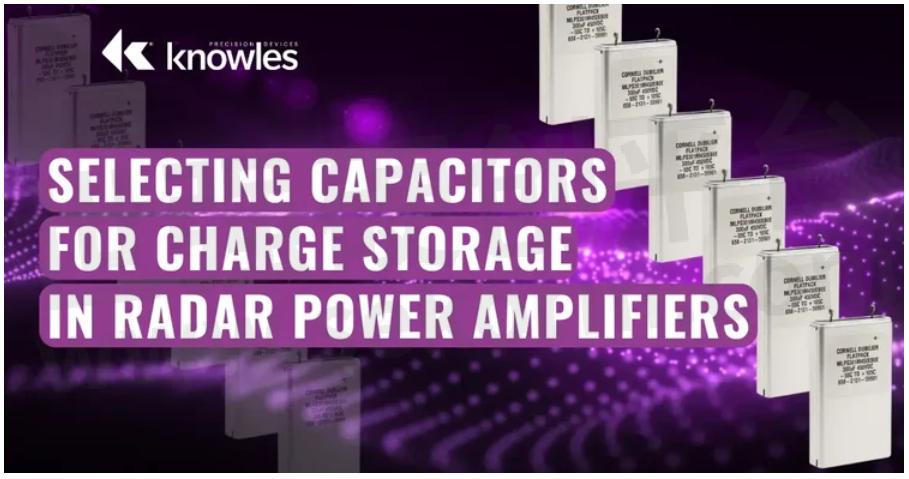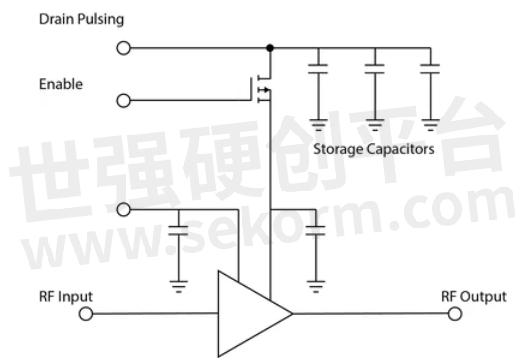Selecting Capacitors for Charge Storage in Radar Power Amplifiers

The types of threats facing radar systems are continuing to diversify. To adapt, the industry is evolving toward fully digital arrays that can support a variety of mission profiles. As these systems grow more and more complex, component-level decisions have an increasingly significant impact on overall performance.

To support the transition to fully digital arrays, power amplifier modules must be designed to fit in smaller and smaller spaces. From functions like signal conditioning to noise reduction, Capacitors support many critical functions in power amplification within radar systems, and the challenge is to get the capacitance required for charge storage within the space allotted.
Achieving the appropriate capacitance often requires a bank of low-profile, surface-mount capacitors, which can consume board space and create self-heating “islands” in the middle of the bank.
Here we’ll review a key consideration for selecting charge storage capacitors, a uniquely important component in transmit amplifier circuits for radar.
The Role of Capacitors in Maintaining Pulse Integrity in Radar Systems
In radar systems, pulse compression improves range resolution and signal-to-noise ratio (SNR), so it’s advantageous, but it introduces other challenges like maintaining the integrity of pulses in the signal chain. Large storage capacitors, usually positioned near the power supply or in a nearby control board, maintain the voltage generated by the source during pulsed operation (Figure 1). Aluminum electrolytic capacitors make excellent storage capacitors because of their high capacitance density. Their presence relieves the switch regulator of handling a higher power load and reduces pulse droop.

Figure 1: Example of power amplification circuit with storage capacitors
Pulse droop describes the decrease in amplitude of a pulse over its duration, which translates to radar range and can affect the accuracy and effectiveness of a radar system. In radar, the challenge is to implement charge storage effectively while evading space constraints and pitfalls like this.
Optimized Capacitor Solutions from Knowles Precision Devices
Knowles Precision Devices offers a variety of capacitors that would be suitable for charge storage applications because of their:
●High energy/capacitance density
●Flat, space-saving configuration
●High operating temperature
●Military-grade status
●High shock and vibe resistance
While there’s a range of flatpack options, the MLPS Flatpack series, a line of low-profile aluminum electrolytic capacitors, offers high capacitance density in a flat configuration. These military-grade capacitors are optimized for 10,000 hours at 105℃, so they’re ideal for T/R modules and other system electronics that maintain high performance and reliability in a small footprint. Consider the MLPS or HVMLS/HRMLS series for high-vibration, high-reliability applications, and MLSG for newer designs featuring cutting-edge technologies and higher performance standards.
With high energy density (i.e., exceeding 0.4 J/cc), a single ULP capacitor offers great bulk storage in a smaller footprint compared to a bank of low-profile SMT capacitors. With a lightweight design, ULP is ideal for portable devices where there are strict parameters for height profile, board space, and weight. Under these conditions, ULP capacitors are a cost-competitive way to improve circuit reliability with a single component.
Balancing energy density, temperature rise, reliability, and construction for radar applications takes a deep understanding of component and material specifications. Knowles Precision Devices is committed to supporting you as you work through your design constraints.
- +1 Like
- Add to Favorites
Recommend
- Knowles Supertweeters Power New EarSonics Precision In-Ear Monitors
- Knowles to Participate in Upcoming Baird Conference in New York on June 4, 2024
- Knowles‘ Microstrip Filters Offer a High Repeatability and Temperature Stability from -55℃ to 125℃
- Knowles Extends Custom Miniaturization Capabilities to MedTech OEMs
- Knowles Introduced the MD Series, A Range of Medical-grade Capacitors for Implantable Designs
- Knowles Partners With Ole Wolff to Deliver Compact Hybrid Driver for TWS Earphones With HD Audio and ANC
- Knowles 3-Cell Supercapacitors Support Significant Jump in Energy Storage
- Knowles and Meizu Bring Treble Performance to New Heights with LIVE AI Noise Cancelling Hi-Fi Earbuds
This document is provided by Sekorm Platform for VIP exclusive service. The copyright is owned by Sekorm. Without authorization, any medias, websites or individual are not allowed to reprint. When authorizing the reprint, the link of www.sekorm.com must be indicated.






























































































































































































































































































































































































































































































































































































































































































































































































































































































